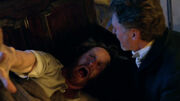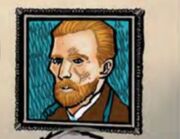Vincent Willem van Gogh (30 March 1853 - 27 July 1890) was a famous Dutch painter of the late 19th century who painted much of his work in France. Van Gogh suffered from intense mental illness. Although largely unknown at the time of his death, he went on to be regarded by Dr Henry Black as one of the greatest painters of all time. (TV: Vincent and the Doctor)
Biography
Early life
Vincent van Gogh was born on 30 March 1853, in Zundert in the Netherlands. (PROSE: The Time Lord Letters) His father was Theodorus van Gogh - a church minister. Vincent was named after his grandfather. In 1864, he was sent to a boarding school in Zevenbergen. (PROSE: Vincent van Gogh)
Becoming an artist
After studying art in Tilburg, Vincent gained employment with Goupil & Cie, who sent him to work in London and Paris. He was successful, but did not enjoy it and soon left.
By 1876, he had become a supply teacher in rural England. However, after a year of teaching Vincent decided he wanted to become a pastor.
In 1877, his father sent him to study theology in Amsterdam, but he failed the entrance exam, and went to work as a missionary instead in the Belgian town of Petit Wasmes. While there, he first began sketching the farmers and coal miners that he saw every day. Vincent lived in virtual squalor, and first showed the symptoms of depression which would trouble him for the rest of his life.
Supported by his brother, Theo van Gogh, Vincent went to study under Willem Roelofs - a Dutch artist, who encouraged him to attend the Royal Academy of Art. Over the course of his studies, Vincent's personal life grew even more turbulent: a series of disastrous love affairs and the death of his father in 1885 drove him even deeper into depression. That same year, Vincent completed his first major work - The Potato Eaters - and began to receive attention on the Paris art scene. In late 1885, he moved to Antwerp to study colour theory, inspired by the paintings of Paul Rubens.
Vincent moved to Paris to live with his brother. While there, he socialised with other up-and-coming artists including Henri Toulouse-Lautrec and was exposed to the works of the likes of Pierre-August Renoir, Claude Monet and George Seurat. Vincent's heavy drinking and partying strained his relationship with his brother.
In 1887, Vincent and Theo were introduced to Paul Gauguin. Vincent and Paul became good friends, often exchanging ideas and painting the same subjects and scenes. (PROSE: Vincent van Gogh)
Deepening depression
By February 1888, having completed over 200 paintings, Vincent was exhausted. He travelled to Arles in the hope that the warmer climate might improve his health. There, inspired by the bright colours of the countryside, Vincent's paintings became more vibrant. He painted some of his most famous works, including The Night Café, Café Terrace at Night and various still life paintings of sunflowers.
Paul Gauguin joined him in Arles in October 1888, but their relationship deteriorated to the point that Vincent threated his friend with a razor blade. Gauguin left Arles and Vincent for good, while Vincent mutilated one of his ears in a delirious, drunken rage. He was hospitalised for a time, then briefly returned home. His neighbours gave him the name 'foux roux' - "the drunken madman" and signed a petition to have him evicted.
Vincent left Arles and was admitted to an asylum in Saint-Rémy-de-Provence where he continued to paint. Upon his release, Vincent went to live in Auvers-sur-Oise to be nearer to both his brother and Doctor Gachet, who had been recommended to him. (PROSE: Vincent van Gogh) He gained a reputation among the locals as a madman and drunkard. He tried to sell his paintings to buy drinks, but without success. Gradually, his depression deepened. (TV: Vincent and the Doctor)
Meeting the Doctor

Krafayis in the church window from van Gogh's original painting. (TV: Vincent and the Doctor)
Van Gogh met the Eleventh Doctor and Amy Pond in 1890. He commented on Amy's beauty and accepted her offer to share a bottle of wine. They were interrupted by locals. A young girl had been found dead. When the Doctor, van Gogh and Amy tried to help her, the girl's mother blamed Vincent for her death and drove him away by throwing stones. Vincent allowed the Doctor and Amy to stay in his home, which was cluttered with paintings he thought worthless. Later, when Amy was attacked by the Krafayis, a seemingly invisible creature, Vincent could see it, allowing him to save Amy and the Doctor.
With some persuasion from Amy and the Doctor, Vincent agreed to help them stop the Krafayis from killing again. However, before they left for the church, Vincent broke down, weeping that like everyone else, Amy and the Doctor would leave and he would be forgotten and alone. When the Doctor tried to empathise, Vincent grew angry and ordered him out. After calming down, Vincent again agreed to help the Doctor, saying that if Amy could soldier on, so could he. As the three of them walked, he told her he could tell she was heartbroken, though she could not.
When they reached the church, he began to paint, despite interruptions from the Doctor. After several hours he spotted the creature in one of the church's windows. When the Krafayis charged on the three, Vincent tried to ward off the creature with his easel. However, it impaled itself on it.
Before the Doctor and Amy left, Vincent admitted that without them, his life would take a downwards turn. The Doctor took Vincent to 2010 to a van Gogh exhibit. Dr Henry Black called him the greatest artist of all time, a man who turned the sorrows of life into the most beautiful art the world had ever seen. Black's description of him as not only the greatest artist but also one of the greatest men of all time reduced Vincent to tears. He thanked Dr Black, who for a moment suspected whom he had just met. Returned to his own time, Vincent thanked the Doctor and unsuccessfully proposed marriage to Amy. He said that he had a new found respect for life. (TV: Vincent and the Doctor)
Final months

Vincent is extremely troubled during his final months. (TV: The Pandorica Opens)
Soon afterwards, however, Vincent was affected by the transmission of the warning signal of Stonehenge about the Pandorica and was plagued with visions of the Doctor's TARDIS exploding, which he painted in The Pandorica Opens. His mental health deteriorated, despite the care of Dr Gachet. In his grief, (TV: The Pandorica Opens) Vincent dedicated Vase with Twelve Sunflowers to Amy. (TV: Vincent and the Doctor)
On 27 July 1890, aged just 37, Vincent shot himself. He died of his injuries two days later. (PROSE: Vincent van Gogh) The final months of his life were described by Dr Black as "probably the most astonishing artistic outpouring in history." (TV: Vincent and the Doctor)
Undated events
At some point, Vincent van Gogh painted a portait of the Sixth Doctor and gave it to him. Peri Brown found it in a TARDIS storeroom. (COMIC: Changes)
Legacy
Dr Black considered Vincent van Gogh the greatest artist of all time, and though worthless in his lifetime, Vincent's works were priceless valuables some time following his death. (TV: Vincent and the Doctor) In 1987, his painting Still Life: Vase With Fifteen Sunflowers sold at auction for almost $40,000,000. (PROSE: Vincent van Gogh) Vincent van Gogh: The Great Innovator was a gallery devoted to him at the Musée d'Orsay, (TV: Vincent and the Doctor) which ran between 17 March and 29 August 2010. (TV: The Lodger)
Harry Sullivan attended another exhibition of van Gogh's work, and met a young woman named Samantha there. Sullivan was later linked to the van Gogh Appreciation Society (a front for the European Anarchist Revolution) and its leader, Zbigniew Brodsky. (PROSE: Harry Sullivan's War)
Some of Vincent's works were displayed in the Paloma Centre, one of the largest collections of art in the universe, which spanned an entire continent. At some point after the 32nd century, the Eleventh Doctor came to the Paloma Centre in search of The Pandorica Opens, afterwards finding that it wasn't there but in his own TARDIS. (PROSE: The War of Art)
James Miller had a reproduction van Gogh on his office wall. (PROSE: Love and War)
Josiah W. Dogbolter had a van Gogh in his art collection. (AUDIO: The Maltese Penguin) On his travels, the Monk, a renegade Time Lord, acquired two paintings by van Gogh which had been lost to history. (AUDIO: The Resurrection of Mars)
Peri Brown was able to identify his style. (COMIC: Changes) Amy Pond saw one of her favourites when meeting him. (TV: Vincent and the Doctor)
Alternate timelines
In a timeline where River Song caused time to collapse when she refused to kill the Eleventh Doctor, (TV: The Wedding of River Song) van Gogh was available on social-networking sites. River Song was a fan of his. (PROSE: Just a Minute...)
Works
Many works by van Gogh are named and/or at least shown in Vincent and the Doctor.

Van Gogh painted a portrait of himself. In 1909, it was kept in the Galerie d'Art de Parisiennes. (COMIC: Gallery) In another one of van Gogh's self-portraits, Vincent had a bandage on one of his ears. Ace once found another version of this same painting in the TARDIS, but with the bandage on the other ear. (PROSE: Echo)
The Fourth Doctor owned at least two paintings by van Gogh, which he kept in the TARDIS: Starry Night and Poppy Flowers. (AUDIO: The Abandoned)
At some point, Vincent met the Doctor and painted a portrait of him. As the Sixth Doctor had the painting in his possession, the painting could not have depicted any incarnation past his sixth. (COMIC: Changes)
Name pronunciation
The American Peri Brown prounounced Gogh the same as as "Go". The Sixth Doctor insisted it rhymed with "Loch". (COMIC: Changes) The Eleventh Doctor, Amy Pond, and Henry Black pronounced his name as "Goff". (TV: Vincent and the Doctor)
